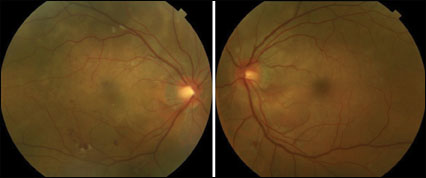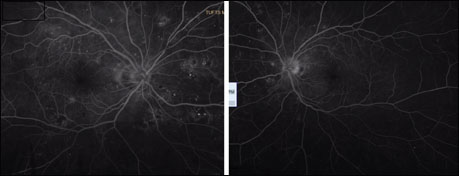Middle-age man presents with bilateral progressive vision loss
Dilated fundus exam revealed mild vitritis, hyperemic optic nerves, scattered cotton wool spots and intraretinal hemorrhages in both eyes.
A 50-year-old Asian man with a history of type 2 diabetes presented to Tufts New England Eye Center with 3 days of bilateral progressive vision loss. He denied any ocular symptoms other than a generalized blurring of his vision that was more severe in the right eye.
His current review of systems was notable for mild diffuse headache. Upon further questioning, he revealed that 3 weeks earlier he experienced several days of severe myalgias and fatigue for which he did not seek medical care, and the symptoms resolved. He had no ocular history before this episode, took no medications or supplements, and had no known allergies. He denied any personal or family history of malignancy or autoimmune disease.
Examination

Source: Lauren Bierman, MD, and Caroline Baumal, MD


Upon examination at NEEC, the patient’s best corrected visual acuity was 20/200 in the right eye and 20/40 in the left eye. Pupils were equal, round and reactive without a relative afferent pupillary defect. IOP was 14 mm Hg in the right eye and 16 mm Hg in the left eye. Conjunctivae were white and quiet, and corneas were clear. The anterior chambers had 3+ cell bilaterally without hypopyon or keratic precipitates, and there were trace nuclear sclerotic cataracts. Dilated fundus exam revealed mild vitritis, hyperemic optic nerves, scattered cotton wool spots, intraretinal hemorrhages and areas of shifting subretinal fluid throughout the posterior pole in both eyes. OCT images of the macula, fundus photos and fluorescein angiography at presentation are shown in Figures 1 to 3.
What is your diagnosis?
See answer on next page.
Progressive vision loss
The differential diagnosis of acute-onset serous retinal detachments in the setting of uveitis includes a host of inflammatory and infectious etiologies. In general, infectious etiologies should be ruled out first, as the therapeutic use of steroids would be contraindicated in infection. Syphilis and tuberculosis are two systemic infections that can cause this presentation. Classically, tuberculous-associated uveitis is a chronic granulomatous disease that produces a disseminated choroiditis with multiple discrete yellow lesions in the posterior pole, with or without associated macular edema and varying degrees of vitritis. The presentation can be quite variable. Syphilis can also have a notoriously variable presentation, affecting any structure in the eye. While syphilitic uveitis is more typical of later-stage disease, it may occur early in the disease course, even in primary infection. Posterior segment manifestations include neuroretinitis, chorioretinitis with vitritis, serous retinal detachments and retinal vasculitis. One distinctive posterior segment presentation of later-stage syphilis is acute syphilitic posterior placoid chorioretinitis, which is typified by a large, yellowish placoid lesion in the macula at the level of the choriocapillaris and retinal pigment epithelium that is associated with diffuse leakage on fluorescein angiography.
There are many inflammatory causes of serious retinal detachments with vitritis, but important initial considerations include posterior scleritis, sarcoidosis, Vogt-Koyanagi-Harada (VKH) disease and sympathetic ophthalmia. Posterior scleritis, itself often the result of an underlying systemic infectious or inflammatory condition, can cause serous retinal detachments via several mechanisms (vascular outflow resistance from inflamed sclera as well as increased vascular permeability due to inflammation) and can be associated with an overlying vitritis. Patients with posterior scleritis, however, typically complain of severe, boring retrobulbar pain. Sarcoidosis should always be considered in any patient presenting with intraocular inflammation, as it has numerous presentations and can affect any ocular tissue. Classically a granulomatous uveitis, sarcoidosis produces posterior segment manifestations including dense vitreous opacities resembling snowballs or a string of pearls, nodular granulomas in the optic nerve, retina and/or choroid, retinal periphlebitis, and even occlusive retinal vascular disease.
VKH and sympathetic ophthalmia are two distinct diseases that share similar immunogenics and are indistinguishable based on clinical exam. Both diseases are characterized by a bilateral, diffuse, granulomatous panuveitis, a thickened choroid and multiple shallow, serous retinal detachments secondary to vascular leakage. The optic nerve may be hyperemic or edematous. Fluorescein angiography may demonstrate multiple areas of hyperfluorescence with pooling of dye beneath the serous detachments, as well as disc leakage. While characteristic integumentary (vitiligo, poliosis), neurologic (headache) and auditory symptoms (tinnitus) have been reported in both diseases, they are far more common in VKH. Patient history is an important distinguishing factor, as a diagnosis of sympathetic ophthalmia requires a preceding history of penetrating ocular surgery or trauma.
Lastly, masquerade syndromes, notably uveal lymphoid infiltration, intraocular lymphoma and metastatic carcinoma, should be included in the differential in the right clinical setting. These may cause subretinal lesions with associated serous retinal detachments and overlying vitritis. In particular, intraocular lymphoma should come to mind in any patient for whom vitritis recurs as anti-inflammatory therapies are tapered. Vitreous biopsy can be diagnostic in these cases.
Because the patient presented here had a history of tinnitus and flu-like symptoms preceding his ocular symptoms, VKH was considered the most likely diagnosis. Therefore, a targeted workup (FTA-ABS, RPR and Quanti-FERON) was undertaken to rule out underlying infection before starting systemic steroids. While awaiting test results, the patient was started on topical steroid four times daily in both eyes and cyclopentolate nightly to prevent formation of posterior synechiae.
Discussion
Vogt-Koyanagi-Harada disease is a multisystem inflammatory disorder that affects pigmented tissues in the eye, meninges, skin and auditory system due to an autoimmune process directed against melanin. The disease is strongly associated with the HLA-DR4 genetic subtype, and there is a higher incidence among people of Asian, Hispanic, Native American and Middle Eastern descent.
The clinical course can be divided into four stages, each with distinct features. The prodromal stage precedes ocular symptoms by several days and resembles a viral infection. Symptoms may be nonspecific (fever, malaise) or may localize to the central nervous system (headache, neck stiffness, vertigo, tinnitus and/or hearing loss). Focal neurologic signs are rare, but can occur. Cerebrospinal fluid samples taken during this stage may reveal a lymphocytic pleocytosis. Ocular symptoms include blurred vision and photophobia, but typically there are no ocular signs. The subsequent acute uveitic phase, in which ocular findings peak, is characterized by diffuse nonnecrotizing granulomatous inflammation. In the anterior segment, there may be anterior chamber cell, granulomatous keratic precipitates, peripheral anterior or posterior synechiae, and scleritis. Ciliary body swelling or detachment may produce anterior chamber shallowing and a myopic shift. Posterior exam will reveal bilateral serous retinal detachments, thickened choroid, vitritis and optic disc edema. Dalen-Fuchs nodules, discrete yellow nodules that denote focal granulomas at the level of the retinal pigment epithelium, may be seen in the retina during this phase. The convalescent phase follows weeks later, accompanied by the resolution of the serous retinal detachments and a gradual choroidal depigmentation described colloquially as a “sunset glow” fundus. The classic dermatologic manifestations of VKH (alopecia, poliosis and vitiligo) occur during this phase as well. Lastly, the recurrent stage may involve a relapse of anterior uveitis as well as the development of cataracts, glaucoma, and possible subretinal neovascularization and fibrosis; however, recurrent posterior uveitis is less common.
During each stage of VKH, multimodal imaging may assist in diagnosis and monitoring response to treatment or disease progression. The classic “starry sky” appearance on fluorescein angiography consists of multiple punctate areas of hyperfluorescence at the retinal pigment epithelium with associated subretinal pooling in areas of serous retinal detachments. This may be accompanied by optic disc leakage. Indocyanine green angiography typically shows delayed choriocapillaris filling with early choroidal hypercyanescence secondary to choroidal inflammation. Areas of hypocyanescence on indocyanine green angiography may indicate the presence of choroidal granulomas. OCT can aid in the diagnosis and management of VKH by demonstrating choroidal thickening, subretinal fluid, fibrin bands within the retina, and subretinal fibrinoid deposits in the acute phase, and choroidal neovascularization or bands of subretinal fibrosis in the chronic phases.
Because there is no single test to diagnose VKH, five clinical criteria are used to classify VKH as complete, incomplete or probable. These diagnostic criteria are no history of ocular trauma, no evidence of other ocular disease processes, bilateral ocular involvement, presence of neurologic or auditory findings, and dermatologic findings. Complete VKH requires that all five preceding criteria are met, while incomplete VKH requires only the first three plus any of the classic neurologic, auditory or dermatologic findings. Probable VKH requires that only the first three criteria are met.
Treatment of VKH involves the early and aggressive use of systemic corticosteroids. Standard therapy employs high-dose oral prednisone (1 mg/kg/day to 2 mg/kg/day) for a minimum of 6 to 12 months with a slow taper after the first 2 to 4 weeks, based on clinical response. Intravenous pulse steroids have not been found to produce superior outcomes to oral steroids but can be used at the ophthalmologist’s discretion. The use of immunomodulatory therapy (IMT) is still a subject of debate in the literature. IMT agents have been used successfully to treat VKH, including cyclosporine, mycophenolate mofetil, azathioprine, chlorambucil, cyclophosphamide and infliximab. While IMT has not demonstrated superiority to corticosteroids, the early use of steroid-sparing medication is an important consideration for patients with frequent recurrences of disease. Visual prognosis in VKH depends on the interval from onset of symptoms to initiation of treatment, as well as the number of recurrences. Complications such as choroidal neovascularization, subretinal fibrosis and glaucoma are associated with poorer visual outcomes.

Clinical course continued
After ruling out syphilis and tuberculosis, the patient was started on 60 mg of oral prednisone in addition to topical therapy with prednisolone acetate 1% and cyclopentolate 1%. Two days later, the patient’s symptoms and exam had improved, and he was then examined weekly. By 1 month, iritis, vitritis and subretinal fluid had completely resolved in both eyes (Figure 4), and his vision improved to 20/25 in the right eye and 20/20 in the left eye. He was slowly tapered off the oral corticosteroids over the next 5 months without recurrence of symptoms.
- References:
- American Academy of Ophthalmology. Basic Clinical Science Course, 2015-2016. Intraocular Inflammation and Uveitis.
- Baltmr A, et al. Clin Ophthalmol. 2016;doi:10.2147/OPTH.S94866.
- Abu El-Asrar AM, et al. Acta Ophthalmologica. 2017;doi:10.1111/aos.13189.
- Giordano VE, et al. Int J Ophthalmol. 2017;doi:10.18240/ijo.2017.01.16.
- Herbort CP, et al. Int Ophthalmol. 2007;doi:10.1007/s10792-007-9060-y.
- Herbort CP Jr, et al. Int Ophthalmol. 2017;doi:10.1007/s10792-016-0395-0.
- Hirooka K, et al. PLoS One. 2017;doi:10.1371/journal.pone.0172612.
- Manethova K, et al. Eur J Ophthalmol. 2017;doi:10.5301/ejo.5000902.
- For more information:
- Lauren Bierman, MD, and Caroline Baumal, MD, can be reached at New England Eye Center, Tufts University School of Medicine. 800 Washington Street, Box 450, Boston, MA 02111; website: www.neec.com.
- Edited by Aubrey R. Tirpack, MD, and Astrid C. Werner, MD. They can be reached at the New England Eye Center, Tufts University School of Medicine, 800 Washington St., Box 450, Boston, MA 02111; website: www.neec.com.
